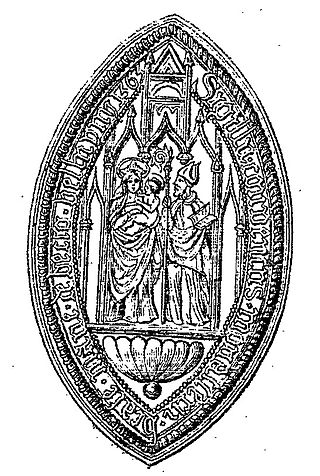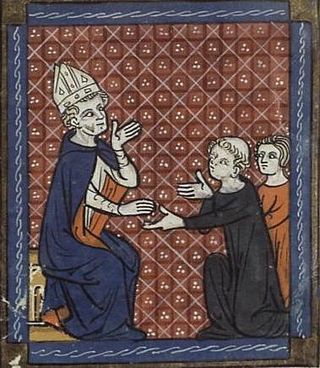Related Research Articles

Robert II, called the Pious or the Wise, was King of the Franks from 996 to 1031, the second from the Capetian dynasty. Crowned Junior King in 987, he assisted his father on military matters. His solid education, provided by Gerbert of Aurillac in Reims, allowed him to deal with religious questions of which he quickly became the guarantor. Continuing the political work of his father, after becoming sole ruler in 996, he managed to maintain the alliance with the Duchy of Normandy and the County of Anjou and thus was able to contain the ambitions of Count Odo II of Blois.

Bec Abbey, formally the Abbey of Our Lady of Bec, is a Benedictine monastic foundation in the Eure département, in the Bec valley midway between the cities of Rouen and Bernay. It is located in Le Bec Hellouin, Normandy, France, and was the most influential abbey of the 12th-century Anglo-Norman kingdom.

Saint Lupus of Sens was the nineteenth bishop of Sens.
Helgaud or Helgaldus, French historian and biographer, was a monk of the Benedictine Abbey of Fleury.
Louis of Lower Lorraine, Frankish royalty and a member of the Carolingian dynasty, was a younger son of Charles, Duke of Lower Lorraine, through his second wife, Adelaide.

Fleury Abbey (Floriacum) in Saint-Benoît-sur-Loire, Loiret, France, founded in about 640, is one of the most celebrated Benedictine monasteries of Western Europe, and possesses the relics of St. Benedict of Nursia. Its site on the banks of the Loire has always made it easily accessible from Orléans, a center of culture unbroken since Roman times. In 2010, the abbey had over forty monks led by the abbot Etienne Ricaud.
Rodulfus, was an 11th-century Benedictine chronicler.

The Diocese of Orléans is a Latin Church diocese of the Catholic Church in France. The diocese currently corresponds to the Départment of Loiret. The current bishop is Jacques André Blaquart, who was appointed in 2010.

The Archdiocese of Sens and Auxerre is a Latin Archdiocese of the Catholic Church in France. The Archdiocese comprises the department of Yonne, which is in the region of Bourgogne. Traditionally established in sub-apostolic times, the diocese as metropolis of Quarta Lugdunensis subsequently achieved metropolitical status. For a time, the Archbishop of Sens held the title "Primate of the Gauls and Germania". Until 1622, the Metropolitan Archdiocese numbered seven suffragan (subordinate) dioceses: the dioceses of Chartres, Auxerre, Meaux, Paris, Orléans, Nevers and Troyes, which inspired the acronym CAMPONT. The Diocese of Bethléem at Clamecy was also dependent on the metropolitan see of Sens. On December 8, 2002, as part of a general reorganization of the dioceses of France undertaken, at least in part, to respond to demographic changes, the Archdiocese of Sens-Auxerre ceased to have metropolitan rank and became a suffragan of the Archdiocese of Dijon, which became the centre of a new ecclesiastical province for the Burgundy administrative region. Consequently the Archbishop of Sens-Auxerre no longer has the privilege of wearing the pallium.

Vaux-de-Cernay Abbey is a former Cistercian monastery in northern France (Île-de-France), situated in Cernay-la-Ville, in the Diocese of Versailles, Yvelines. The abbey was abandoned during the French Revolution and fell into partial ruin. Most of the buildings, except for the church, were restored in the late 19th century by Charlotte de Rothschild, and the property is now a hotel.
Smaragdus of Saint-Mihiel OSB was a Benedictine monk of Saint-Mihiel Abbey near Verdun. He was a significant writer of homilies and commentaries.

Henri de Contenson was a French archaeologist and a researcher at the CNRS, The Centre National de la Recherche Scientifique, a research organization funded by France's Ministry of Research.
The Abbey of Saint-Pierre-le-Vif was a Benedictine monastery just outside the walls of Sens, France, in the Archdiocese of Sens.
Bouchard de Bray, also Bouchard I of Montmorency was a French knight from the Tenth Century. he was the ancestor of the noble House of Montmorency and the noble House of Montlhery.
Wenilo was the archbishop of Sens from 836 or 837. Prior to becoming bishop, Wenilo was a palatine chaplain. As bishop, he was one of the leading men in Aquitaine and crowned Charles the Bald king in 848, definitively uniting Aquitaine with West Francia. In 858, he supported the East Frankish invasion and was denounced as a traitor by the king. They reconciled the next year, and Wenilo retained his office until his death. Nevertheless, he passed into legend as Ganelon, the archvillain of the Matter of France, his name a byword for "traitor".

The Abbey of St. Marianus was a Benedictine, later Premonstratensian, monastery in Auxerre in the French department of Yonne in Burgundy. Established in the fifth century, it was the first monastery established in the diocese.
The sacred relic of Saint George was one of the most famous of relics, after the True Cross and Holy Lance, and was the arm of the Saint George, ordered killed by the Roman Emperor Diocletian for his failure to renounce his faith in Christ. George, a secondary patron saint of the First Crusade, played a significant role and provided other relics, as the occupation of his tomb at Lydda marked the first Latin bishop of Jerusalem as well as a service to ask for his intervention. The arm was given to the abbey of Anchin by Robert of Jerusalem at some time during the Jerusalem campaign.

Thibault Métezeau or Thibaut Métezeau was a French architect. He was the son of Clément Métezeau, master mason and father of architects Louis and Clément II Métezeau. He was the younger brother of Jean Métezeau, also an architect.
The Chronicle of Saint-Pierre-le-Vif of Sens is an anonymous Latin chronicle written at the Abbey of Saint-Pierre-le-Vif in Sens between about 1100 and 1125 with continuations added into the 13th century. The original work was attributed to a monk named Clarius by Dom Victor Cottron in 1650, but this is not now accepted. It is, however, sometimes still labeled the Chronique dite de Clarius. The Chronicle is mainly a history of the abbey and of the city of Sens.
Monique de Saint-Martin is a sociologist born in France.
References
- ↑ Robert-Henri Bautier and Monique Gilles, "Introduction," in Bautier and Gilles, eds. and trans. Odorannus de Sens. Opera omnia, Paris: Editions du centre national de la recherche scientifique, 1972, p. 8.
- ↑ Odorannus de Sens, Opera omnia, p. 101-13.
- ↑ Odorannus de Sens, Opera omnia, p. 101.
- ↑ See Bautier and Gilles, "Introduction," pp. 11-16.